 |
surfresearch.com.au
gartner : water sled, 1933 |
| home | catalogue | history | references | appendix |
|
| Page 84.
You are 300 feet off the beach in a heaving warm surf.
The sea lifts and starts to break.
The original Hawaiian water sleds or surf boards are solid planks
of light native wood.
Blake was a life guard at Waikiki and these are his own plans. |
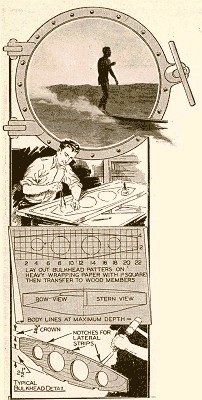 |
Of course, it is understood you are not to build a sled for sale.
The new sled is bigger and lighter than the Hawaiian article.
The hollow surf board is operated with the rider lying upon his
stomach on the rear haIf.
Holding his head up he rotates his arms at the shoulders, simultaneously
dipping with both hands as if they were the oars of a boat.
When underway, the board fairly skims the surface, its bow high,
the top surface of the stern at water ...
Page 85.
... level.
It is very sensitive to applied power and may be stopped within
a few feet by the operator dragging both feet and hands.
| Sled Easily Carries Two Persons
In the case of a rescue the water sled can carry two persons almost as easily as one. The second person, possibly a near victim of drowning, rides in almost the middle of the board, held steady by the operator's shoulders and arms. Although the Hawaiian water sled was developed primarily as an aid in lifesaving, it has become quite popular as a craft for racing and taking short cruises, so to speak. A person possessing strong, supple shoulders can readily travel
distances which may be measured in miles. Paddling the board is emphatically
a sporting way to develop the shoulders and back muscles.
The sides taper from a pointed 2 1/2 - inch stern to a rounded
1 - inch bow.
|
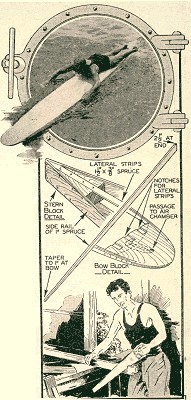 |
Page 86
... board, 4 1/2 inches, being two thirds of the length forward.
The greatest beveled thickness in the top deck is 3/4 of an inch,
while in the bottom it is 1 1/2 inches.
The frame of the water sled is entIrely of spruce.
There are from 10 to 13 transverse braces 3/4 of an inch thick,
with holes bored or scrolled to eliminate weight and to make the interior
of the board a single air chamber.
There are three lateral braces along the top and three along
the bottom, each 1 1/2 inches wide and 3/4 of an inch thick.
The rails,1-inch wide, are steamed to bend and grooved to receive
the deck.
They taper from a blunty-pointed stern block, 8 inches long by
21/2 inches deep, to a rounded bow block, 8 inches long by 1 inch deep.
The material of the decks may be 3-ply veneer, or 3/16-inch or,
perhaps, 1/8-inch Masonite Tempered Presdwood.
It is joined to the grooved rail with Number 10 flat-headed brass
screws every 1 or 11/2 inches.
It is advisable to insert them every inch along the bow and stern.
The seam is made watertight by the use of Jeffery's quality C
marine glue and 3/4-inch cloth tape. When closing the seam, first put a
layer of glue, then the tape, and lastly another application of glue before
the deck is screwed tightly down.
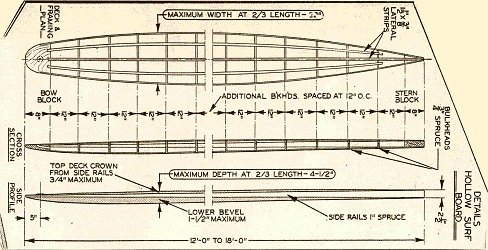
In either the bow or stern block a 2-inch deck plug with an air
lock is inserted to allow for ventilation, drainage, and air expansion.
A hole drilled into the inner end of the block will connect the
valve with the great air chamber.
It should be remembered that, immediately after using, the valve
of the water sled must be opened to release air which ordinarily has expanded,
especially during a hot day.
Otherwise, there is a chance that the bulging decks may tear
loose the screws from the rails.
If you care to add another air lock (which may be a valve from
an auto inner lube) you can put an inner tube in the sled which will keep
it afloat if you smash it against rocks or wreckage while you have a cargo
on it which must be supported.
Accompanying sketch showing man pumping up inner tube does not
mean sled itself is inflated.
There would be no point in doing this: The original air lock
is there to equalize the pressure inside and outside the sled.
For protection against water which may have seeped into the hollow
board, the inside should be treated with oil, paint, or other preservative.
The outside, naturally, is best finished with marine paint covered
with several coats of spar varnish.
It will pay an owner of a water sled, especially where salt water
is his highway, to wash his decks with fresh water after an excursion and
then dry them with a towel.
Like a fishing rod or the deck of a yacht the board may require
frequent coatings of spar varnish.
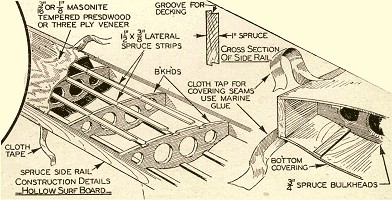 |
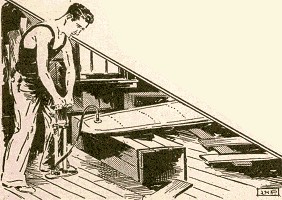 |

| home | catalogue | history | references | appendix |